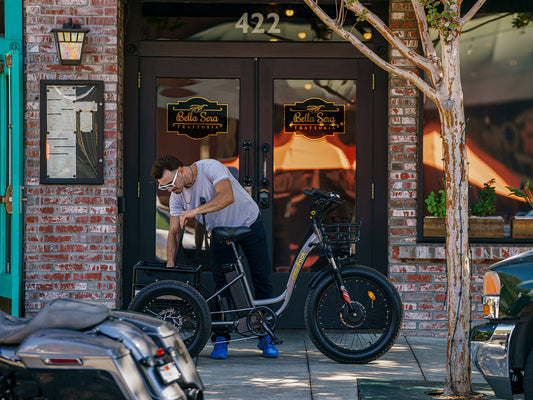More people are turning to e-bikes as they offer a greener and healthier mode of transportation for daily commutes.
Electric bikes have an integrated electric motor that assists while pedaling. This additional power allows riders to cover longer distances and tackle steeper hills with ease, making them a popular choice for both urban and rural commuters.
If you're considering making the switch to an e-bike, here are 10 tips to help you get started:
1. Choose the right e-bike
The first step in starting your e-bike commute is the selection of the right e-bike which fulfills all your needs. There are several types of e-bikes available, each with its own unique features and specifications. Some popular categories include:
- Pedal-assist e-bikes:These bikes only assist when you pedal, giving you a more natural cycling experience while still benefiting from the added power.
- Throttle-assist e-bikes:These E-bikes let you control the speed directly with a throttle, and provide power even when you're not pedaling. Maxfoot produces all throttle-assist electric bikes
- Folding e-bikes:These bikes can be easily folded, which makes them an ideal choice for those with limited storage space or those who need to carry their bike on public transportation.
One of the best bikes in this category is Maxfoot MF-19. It is a 1000W folding electric bike, making it a powerful and portable choice for your next commuting journey.
- Full suspension folding electric bikes:These bikes are not only foldable but also bear a full-suspension system, which helps you travel comfortably on all types of terrain.
2. Invest in essential accessories
Once you have chosen the right e-bike, next invest in some key accessories to ensure a safe and comfortable commute. Some must-have items for bikers include:
- Helmet:To protect your head from injury in case of an accident.
- Lights and reflectors: To increase your visibility to other road users, especially during low-light conditions.
- Cable Lock:To secure your e-bike from theft when parked in public spaces.
- Mudguards: For keeping debris off your clothes and bike.
- Backpack:For carrying your belongings with ease.
3. Plan your route
Prior to commuting on your e-bike, plan your route to ensure a smooth ride. Use online mapping tools like Google or Apple apps to find the most direct and safest route. You can e-bike on lanes and paths, avoiding busy roads and traffic.
4. Optimize your Bike range
One of the primary concerns of e-bike commuters is maximizing their bike's range to ensure they can complete their journeys without running out of battery power. Here are some tips to optimize your e-bike's range:
- Most e-bikes come with multiple levels of assistance. Experiment with the different levels to find the sweet spot between assistance and battery life.
- Ride at a consistent speed, rather than frequently accelerating and decelerating, which will help conserve battery power
- Keep your belongings to a minimum and only carry what's necessary for your commute
5. Prepare for changing weather conditions
E-bike commuting often means facing various weather conditions, so you need to remain prepared for all sorts of conditions.
Invest in waterproof clothing to keep you dry during rain showers. Wear layers to adjust your clothing based on the temperature. Additionally, keep an eye on the weather forecast when making travel plans and adjust them accordingly.
6. Maintain your e-bike
To keep your e-bike running smoothly and safely, regular maintenance is crucial. Some basic maintenance tasks before you take a long ride include :
- Check if your bike tires are properly inflated
- Adjust your brakes
- Lubricate bike chain
- Inspect your e-bike for any loose bolts or damaged parts
If you're unsure about any maintenance tasks, it’s best to consult your e-bike's user manual or visit a local bike shop for assistance.
7. Practice good battery management
Maximizing your e-bike's battery life will ensure you have enough power to complete your commute. Here are a few tips for managing your battery:
- Charge your battery fully before each ride
- Use the lowest level of assistance necessary to conserve power
- Avoid excessive use of the throttle, if applicable
- Storing your battery in a cool, dry place when not in use
With good battery management practices, you can your battery's lifespan and save you money in the long run.
8. Learn the local laws and regulations
E-bike laws and regulations vary depending on your location, so it's essential to familiarize yourself with the rules that apply to your area to avoid the risk of fines. Some things to beware of:
- Speed limits for e-bikes on bike paths or roads
- Helmet requirements
- Age restrictions for e-bike riders
Being aware of and following these rules will ensure a safe and legal e-bike commute.
9. Practice good cycling etiquette
When commuting on your e-bike, it's crucial to be a courteous and responsible rider. Follow these rules to keep yourself and other people on the road safe:
- Give pedestrians the right of way
- Signal your turns and lane changes
- Don’t ride too close to other cyclists or vehicles
- Keep to the right and pass on the left
These guidelines will help create a safer and more enjoyable environment for all road users.
10. Be prepared for emergencies
Even with careful planning and preparation, emergencies can still happen during your e-bike commute.
It's essential to be prepared for these situations by carrying a basic repair kit and bandage kit for vehicle abnormalities or accidents., Make sure you know how to use these tools and consider taking a basic bike maintenance course to boost your confidence in handling minor repairs.
Final Thoughts
Make sure to enjoy and take advantage of e-bike commuting. Not only will you be reducing your carbon footprint and contributing to a greener environment, but you'll also improve your physical fitness.
Embrace the freedom and fun that e-bike commuting offers and watch as your daily commute transforms into a more enjoyable and rewarding experience.




